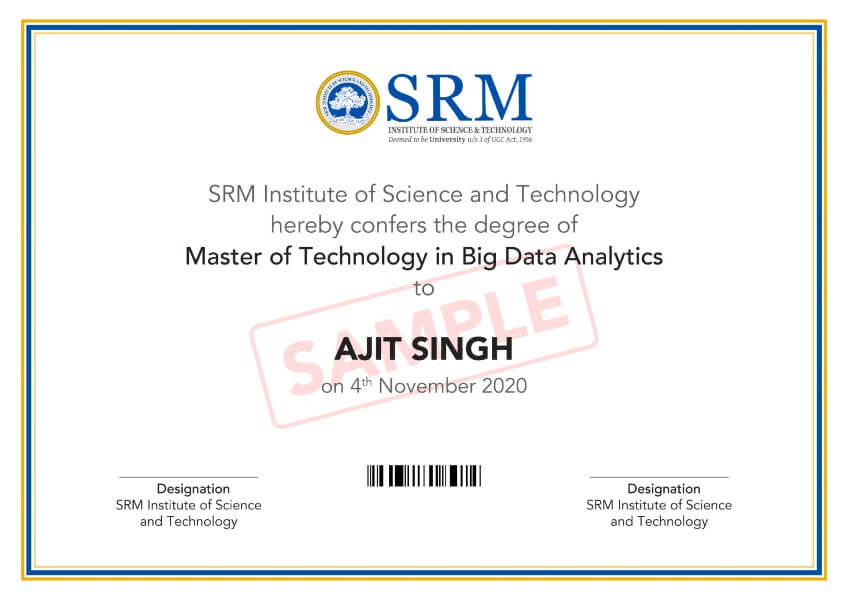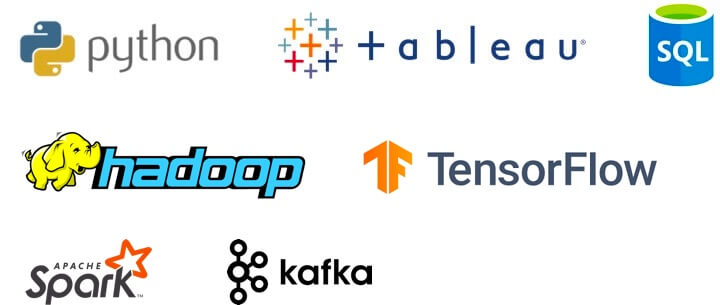The curriculum of the M.Tech in Data Science and Big Data Analytics offered by SRM is highly comprehensive. It is designed by the highly skilled and experienced professionals of Data Science and Big Data Analytics. Let us learn about the several concepts covered in the curriculum of the Data Science and Big Data Analytics training.
Module -1
Multivariate Techniques for Data Analytics
Multivariate Data Analysis is basically the analysis of the multivariate datasets.
What is a multivariate dataset?
A data in which multiple variables are recorded on each unit is called a multivariate data set.
Multivariate analysis used to perform Data reduction, clustering, investigate relationships among the variables, prediction, and much more.
Below are the various concepts of Multivariate Techniques for Data Analytics you would master in this module
- Exploratory data analysis
- Feature engineering
- Descriptive statistics
- Probability & Distributions
- Hypothesis testing
- ANOVA, ChiSquare
- Statistical Simulation Techniques
Module -2
Computing for Data Analytics
The ability to process large databases and use efficient computing systems plays a key role in getting things done in Big Data Analytics. Several statistical models are employed in processing big data.
Below are the various concepts of Computing for Data Analytics you would master in this module
- Linear Regression - Model building & Fine tuning
- Regularization Techniques
- Model deployment
Module -3
Big Data Technology
Big Data Technologies are essential components of Big Data Analytics. They are used to perform an accurate analysis of big data. Big Data Technologies are employed to derive the most meaningful insights and accurate predictions. Big Data Technologies assist in risk reduction. Big Data Technologies are of two types. They are Operational Big Data and Analytical Big Data.
Below are the various concepts and tools of Big Data Technology you would master in this module
- Hadoop- Hadoop uses distributed file systems known as Hadoop Distributed File System to store big data.
- HDFS and Map Reduce
- NoSQL and MongoDB
- Batch processing (Hive, HBase)
- Real-time processing (Spark, Kafka)
Module -4
Machine Learning for Data Analytics
Machine Learning is an important subset of the most exciting technology called Artificial Intelligence. The idea behind Machine Learning is to build intelligent machines that think and act like humans do without being specifically programmed. The tools and techniques of Machine Learning are employed in Big Data Analytics.
Below are the various concepts and tools of Machine Learning for Data Analytics you would master in this module
- Logistic Regression
- K-Nearest Neighbours
- Decision Trees
- Ensemble Techniques
- Random Forest
- Clustering techniques
- K-means algorithm
- Dimensionality reduction
- Recommender system
Module -5
Advanced Algorithms Analysis
Advanced algorithms are nothing but the algorithms built upon the existing ones that could perform advanced analytical operations. Advanced algorithms are developed with an increased ability to analyze. Advanced algorithms are built considering different types of existing models within which to analyze algorithms.
Below are the various concepts and tools of Advanced Algorithms Analysis you would master in this module
- Graph algorithms
- Network Algorithms
- Distributed Algorithms
- Document Processing
Module -6
Python Programming for Data Analytics
Python is one of the most popular programming languages applied in the latest technological domains such as Data Science, Machine Learning, Big Data Analytics, and more. Python plays a crucial role in performing Big Data Analytics.
Below are the various concepts of Python Programming for Data Analytics you would master in this module
- Python basics
- Data structures & data handling
- Functions
- Numpy
- Pandas
Module -7
Natural Language Processing Techniques
Natural Language Processing refers to the application of Artificial Intelligence which is communicating with an intelligent system using the natural language.
Text mining or text analytics is the process of deriving meaningful information from natural language text. The process of NLP involves the process of structuring the input texts deriving patterns within the structured data ana finally evaluating and interpreting the output. NLP techniques are applied to turn the natural language text into data analysis.
Below are the various Natural Language Processing Techniques you would master in this module
- Text Analytics - Basics
- Document summarization and classification
- Web Scraping
- Sequential Modelling
- Transformers
Module -8
Deep Learning for Data Analytics
Deep Learning is the subset of Machine Learning whereas Machine Learning is the subset of the most exciting technology called Artificial Intelligence. Deep Learning is one of the core elements employed in Big Data Analytics. The idea behind Deep learning is to build self-learning algorithms that mimic the human brain. Deep Learning is implemented through neural networks which are nothing but the human brain cells.
Below are the various Deep Learning for Data Analytics you would master in this module
- Neural networks
- Tensorflow and Keras
- Computer Vision, CNN, and Applications
- Transfer learning and Applications
- Object detection, Siamese Networks, GANs
Module -9
SQL & DBMS
SQL
SQL refers to Structured Query Language. It is the standard language used to deal with databases. SQL is used to perform various operations on data such as insert, search, update, delete the database records. SQL helps in optimizing and maintenance of databases and much more.
DBMS
A database is nothing but a systematic collection of Data. As th3e data in a Database is organized, it makes data management easy. DBMS stands for Data Base Management System which is a collection of programs that enables its users to access databases, manipulate data, and help in the representation of data. It also helps control access to databases through various users.
Below are the various SQL & DBMS tools and techniques you would master in this module
- Database concepts
- Data Models and SQL
- Subqueries & Joins
- Analytical / Window Functions
- Transaction Processing - ACID properties











 and
more...
and
more...

 View Experience
View Experience




 5,00,000
5,00,000






